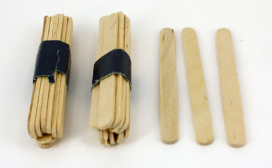Diagnostic questions
Assess the student’s recall of addition and subtraction of basic facts. Each question should be both read aloud and given to the student in writing. If necessary, put questions into a story context and observe the methods the student uses to solve them.
Doubles/halves to 10: For example, 3 + 3 and half of 8 …
Doubles/halves to 20: For example, 6 + 6 and half of 14 …
Doubles/halves to 100: For example, 30 + 30 and half of 40 …
If the student can recall the doubles, try near doubles, for example, 8 + 7, 29 + 30, …
What to notice in the student’s response
Can the student recall basic facts with ease?
Does the student use strategies such as counting, nodding, or using their fingers?
 Deliberate acts of teaching
Deliberate acts of teaching
Materials/Links
- Sticks and bundles
- Double Somersaults (Material master 4-33) (PDF, 86KB)
Knowing the doubles to 20 and the double-digit doubles to 100 is useful for the development of part–whole thinking and can be used as a building block for the first set of multiplication facts (the 2 times tables). The inverse of these facts, the halves, can be taught at the same time.
Teaching a basic facts set begins with teaching the student strategies and then providing opportunities for practice until the fact becomes known. Use a concrete model to explore what each set means. Make links between known and new facts.
To teach doubles, create two egg-carton “tens frames” (two rows of five cups).
Doubles to 10: Start with one egg-carton frame. Working with single sticks, demonstrate the doubles by placing the sticks side by side down the frame, emphasising the symmetry. Continue until the student has fast and fluent recall. Give a set of flashcards to the student for additional practice.
Doubles to 20: Place the second egg-carton frame in front of the student, slightly below the first. Fill the first frame one fact at a time. When you get to 6 + 6, emphasise that you are moving to a new frame. Support the student to “see” 10 + 2 (“5 + 5 makes 10 plus 2 more”). Repeat with each new double. Discourage “counting all” or “counting on in ones”. For example, for 7 + 7 = 14, explain that you can see the 10 and the 4 without counting. Make a second set of flashcards using paper of a different colour.
Easy doubles to 100: Reuse the egg-carton frames but replace the single stick with bundles of ten sticks. Ensure that the student can count in tens to 200 and can record and read multiples of 10 to 200. When building this set of basic facts, move back to the early doubles or known facts. When you reach 60 + 60, remind the student that a full 50 + 50 frame makes 100, so the 60 + 60 is 100 + 20. Make a third set of flashcards using a different colour.
- 1 + 1 = 2, 1 ten + 1 ten = 2 tens, 10 + 10 = 20
- 6 + 6 = 12, 6 tens + 6 tens = 12 tens, 60 + 60 = 120
Seeing Nearly Double
The above sequence can be used to also teach the “near doubles”, for example,
- 8 + 8 = 16, 8 + 7 = 15
- 30 + 30 = 60, 29 + 30 = 59
Use the Double Somersaults game (PDF, 86KB) for practice.
What to do next if the student is stuck
Reduce the number of basic facts. Move back to working on smaller chunks (for example, doubles to 6) until the student can recall them with confidence.
Emphasise links between prior knowledge and each new basic facts set.
Initiating home-based activities
Give the student flashcards to take home for extra practice. Explain to parents the importance of the student working out the answer without counting.
Next teaching steps back in the classroom
Incorporate doubles into number and measurement work, encouraging the student to identify and use their knowledge of doubles to solve problems. Use real contexts so that practice is not limited to flashcards. Emphasise that recognising and recalling doubles are useful strategies when solving problems.